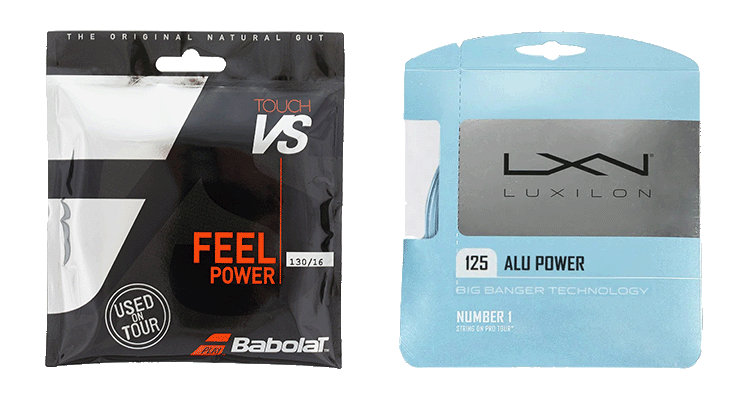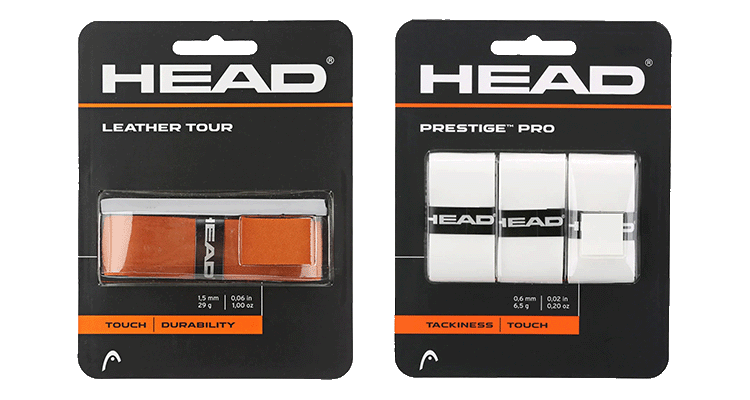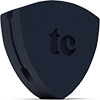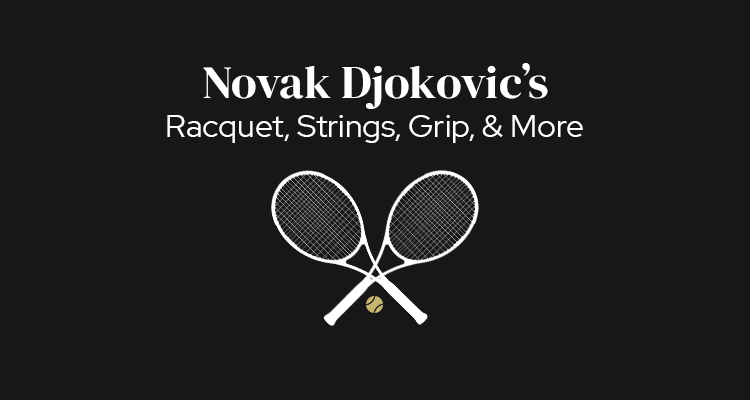Check out my custom vibration dampener
Novak Djokovic’s Racquet, Strings, Grip & More
Gear Guide
We hope you love this article. Just so you know, TennisCompanion may collect a small share of sales from the links on this page to help keep this site running. Learn more.
Edging out Rafael Nadal and Roger Federer, analysts and fans widely consider Novak Djokovic to be the best tennis player ever, boasting an impressive resume with a record 23 Grand Slam titles and 95 overall.
Throughout his career, Novak has displayed incredible resilience, an immense passion for the sport, and an unwavering commitment to improving his game through any means necessary, including the gear he uses to perform his best on the world’s biggest stages.
In this guide, I uncover Djokovic’s racquet model from Head, along with its detailed specs, strings, tension, and more, so you can explore all the nuances that make his setup unique and determine if any of the equipment he uses is a good fit for your needs.
| Type | Gear Djokovic Endorses |
| Racquet | Head Speed Pro |
| Main Strings | Babolat Touch VS 16 |
| Cross Strings | Luxilon ALU Power 16L |
| Dampener | Head Djokovic Dampener |
| Grip | Head Leather Tour |
| Overgrip | Head Prestige Pro |
| Shoes | Asics Court FF |
| Bag | Head Pro X XL |
| Apparel | Lacoste |
Article Contents
Click below to jump to a section
Tap below to jump to a section
Racquet
Strings
Shoes
Apparel
New to TennisCompanion?
Create a free account and explore my latest videos below
Racquet
As is typical with professional tennis players, the racquet Novak Djokovic uses is different than the one he endorses, so I’ll review each frame individually and share how and why they differ.
Actual Racquet: Head PT 346.1

Novak Djokovic uses a pro stock model from Head called PT 346.1, based on the mold of an older retail frame the company used to manufacture the Liquidmetal Radical Tour, TiRadical, and iRadical racquets that were popular in the early 2000s.
Pro stock refers to racquets that manufacturers develop exclusively for professional tennis players they sponsor, typically based on older models that top tennis brands no longer sell to consumers.
It’s best to think of the PT 346.1 as a model number or SKU for a specific mold, which Head uses as an efficient way to track all frames they’ve developed. Head first assembles the graphite layup, then uses the mold, intense heat, and internal pressure to construct the frame, which they further customize to a player’s specifications.
Using the PT 346.1 model, Head periodically develops a batch of racquets for Novak Djokovic with the following specs.
| Spec | Novak’s Racquet |
| Head Size | 95 in² (612.90 cm²) |
| Length | 27.10 in (68.83 cm) |
| Strung Weight | 12.45 oz (353 g) |
| Balance | 32.4 cm / 6pts HL |
| Swingweight | 360 |
| Stiffness | 60 |
| Beam Width | – |
| String Pattern | 18×19 |
| Composition | Graphite |
| Grip Size | 4 3/8 in |
| Grip | Head Finest Calfskin Leather* |
| Overgrip | Head Prestige Pro** |
| Main String | Babolat Touch VS – 16 (1.30) |
| Cross String | Luxilon ALU Power – 16L (1.25) |
| Main String Tension | 59 lbs (26.8 kg) |
| Cross String Tension | 56 lbs (25.4 kg) |
Overall, Head designs the attributes of Novak’s racquets, including a smaller head size and tighter string pattern to help deliver maximum control and precision with a heavier weight that most players would find overbearing. However, for Novak, the extra weight provides exceptional stability and feel, which is beneficial at his level to stand up to the pace he faces against top opponents.
The racquet also has a thinner 22 mm beam, which allows the frame to flex more when striking the ball, further reducing power, improving control, and providing Novak with exceptional feel.
*Unfortunately, Head doesn’t sell this leather grip anymore. Instead, you’ll find the Head Leather Tour replacement grip.
**Novak wraps his leather grip with two overgrips, each adding 1/16 inch to his grip size.
Previous Racquet: Head PT 113B
Previously, Novak used the Head PT 113B but retired this model in 2018 after working with Andre Agassi for a brief stint. Andre introduced him to Master Racquet Technician Roman Prokes, who he had worked closely with throughout his career and is renowned for his customization efforts.
In short, Novak needed to modernize his racquet to continue to compete at the highest level while also taking some pressure off his elbow, which required surgery in late January 2018. Ultimately, Roman aimed to find minor incremental improvements that would enhance his game without resulting in a frame that felt too foreign.
First, they opened up the string pattern from 18×20 to 18×19 for extra bite and easier spin production. They also reduced the frame’s weight by eight grams to improve its maneuverability and extended the length by 1/16 of an inch for a bit of added power and stability.
Here are the specs of his current frame alongside the older model he used so you can see how they compare.
| Spec | PT 346.1 (Current) | PT 113B (Previous) |
| Head Size | 95 in² (612.90 cm²) | 95 in² (612.90 cm²) |
| Length | 27.10 in (68.83 cm) | 27 in (68.58 cm) |
| Weight | 12.45 oz (353 g) | 12.73 oz (361 g) |
| Balance | 32.4 cm / 6pts HL | 32.8 cm / 5pts HL |
| Swingweight | 360 | 370 |
| Stiffness | 60 | 60 |
| Beam Width | 22mm / 22mm / 22mm | 22mm / 22mm / 22mm |
| String Pattern | 18×19 | 18×20 |
| Composition | Graphite | Graphite |
| Grip Size | 4 3/8 in | 4 3/8 in |
| Grip | Head Finest Calfskin Leather | Head Finest Calfskin Leather |
| Main String | Babolat Touch VS – 16 (1.30) | Babolat Touch VS – 16 (1.30) |
| Cross String | Luxilon ALU Power – 16L (1.25) | Luxilon ALU Power – 16L (1.25) |
| Main String Tension | 59 lbs (26.8 kg) | 59 lbs (26.8 kg) |
| Cross String Tension | 56 lbs (25.4 kg) | 56 lbs (25.4 kg) |
These may seem like minor changes, but small tweaks can make a significant difference for a player of Novak’s caliber, especially when combining several modifications.
Novak’s Custom Wilson Racquet
Novak’s partnership with Head is long-standing, but if you look back far enough, you’ll notice he briefly switched from Head to Wilson starting in 2005, two years after he turned pro in 2003.
At the time, Wilson created a custom racquet for Novak to match his existing Head Liquidmetal Radical frame because he couldn’t find a racquet with their lines that worked well for him.
These days, you’ll find reference to that model as Wilson’s H22 pro stock frame, the predecessor to the current Wilson Blade racquets, and the manufacturer’s response to Head’s Radical franchise. Overall, a very similar frame.
Novak continued using Wilson racquets through 2008, including when he won his first Grand Slam trophy at the Australian Open. However, he eventually switched back to Head in 2009.
Endorsed Racquet

Despite playing with a racquet modeled after an earlier version of Head’s Radical line, Novak endorses the Head Speed Pro, which offers similar playing characteristics but is an entirely separate frame with different specs.
Head paints Novak’s racquets to look like the latest model of the Speed Pro, which gives the perception that he uses that frame and helps the company market and sell racquets.
That’s why it appears Novak changes racquets roughly every two to three years when Head releases a new model of the Speed line when, in reality, it’s just a new batch of his old racquets painted to look like the latest version.
Here’s a comparison between the specs of his current racquet (PT 346.1) and the model he endorses (Head Speed Pro).
| Spec | Actual Racquet (PT 346.1 ) | Endorsed Racquet (Head Speed Pro) |
| Head Size | 95 in² (612.90 cm²) | 100 in² (645.16² cm) |
| Length | 27.10 in (68.83 cm) | 27 in (68.58 cm) |
| Weight | 12.45 oz (353 g) | 11.5oz (326g) |
| Balance | 32.4 cm / 6pts HL | 32.5cm / 6 pts HL |
| Swingweight | 360 | 326 |
| Stiffness | 60 | 62 |
| Beam Width | 22mm / 22mm / 22mm | 23mm / 23mm / 23mm |
| String Pattern | 18×19 | 18×20 |
| Composition | Graphite | Graphite |
| Grip Type | Head Finest Calfskin Leather | Head Hydrosorb Pro |
Across the board, there are some significant differences between the two. The Head Speed Pro has a larger head size, affording players more power and margin for error. It’s also lighter, comes in the standard length of 27 inches, has a thicker 23mm beam, and a tighter 18×20 string pattern, so it’s clearly not the same racquet.
Of course, that doesn’t make the Head Speed Pro a poor choice. It’s an excellent racquet built for the modern game and ideal for experienced players who demand control and precision. However, it won’t be as low-powered as Novak’s racquet and offers better spin potential.
Buying Novak’s Racquet
If you want to purchase a racquet that resembles Djokovic’s, the following racquets will meet the criteria. These frames share the same paint job you’ll find on his racquet.
- Head Speed Pro
- Head Speed MP
- Head Speed Team
- Head Speed Team L
However, if you want to purchase the actual racquet Novak Djokovic plays with, it’s not easy. Unfortunately, since he plays with a pro stock racquet, his frame is not readily available for purchase.
Generally, the only way to get your hands on one will be through an auction where his racquets fetch thousands of dollars, making them virtually inaccessible to the general public. Alternatively, you might become a lucky fan to whom Djokovic gives a racquet after a match, which he has done on several occasions, but don’t hold your breath.
Ultimately, you’ll be better off focusing on your needs rather than seeking to purchase the same model Novak uses since he’s customized his racquet to work for his game, which is undoubtedly different than yours.
Strings

Novak Djokovic uses a hybrid string setup consisting of Babolat Touch VS in the mains and Luxilon ALU Power in the crosses. Both are excellent, and they’re two of my picks for the best tennis strings, which are highly popular.
| Spec | Babolat Touch VS | Luxilon ALU Power |
| Gauge | 16 / 1.30 mm | 16L / 1.25 mm |
| Length | 40 ft / 12 m | 40 ft / 12 m |
| Composition | Natural Gut | Co-polyester Monofilament |
| Color | Natural | Silver |
| Tension | 59 lbs ( 26.76 kg) | 56 lbs (25.40 kg) |
A hybrid string setup gives Novak a unique blend of performance characteristics by integrating two entirely different types of string.
Babolat VS Touch is natural gut, which delivers exceptional feel and power. Meanwhile, Luxilon ALU Power is a low-powered polyester string offering best-in-class spin and control.
Combined, these two strings are a formidable pair, delivering a well-balanced performance that’s ideally suited for Novak’s all-court style of play.
It’s worth noting that when stringing hybrid, the string a player chooses in the mains dominates the overall feel of the racquet, so Novak is opting for a softer, more forgiving response while looking to enhance spin through the introduction of a polyester string in the crosses.
Regarding tension, Novak strings his strings the mains at 59 lbs ( 26.76 kg) and the crosses at 56 lbs (25.40 kg). However, he’ll sometimes vary tension to better suit the conditions, which he determines by practicing on-site before and during a tournament, giving any necessary feedback to the stringer to dial in his preference.
Players stringing with a hybrid setup often vary the tension of the mains and crosses to optimize for spin, allowing for more significant string movement and enhanced snapback. In this case, Novak is opting for a 3 lb (1.36 kg) difference in tension. Although seemingly insignificant, this small change has a prominent impact on performance, especially at the elite level.
Novak’s string setup is solid and will work well for many players. However, it does have downsides. Notably, he’s using two of the most expensive strings on the market, with most of the cost coming from natural gut. As a less expensive alternative, I’d encourage you to check out multifilament strings, which deliver similar performance at a fraction of the price.
Vibration Dampener
Novak uses the Head Djokovic Dampener, a signature model featuring the head logo on one side and his branding on the other.
Some players install these small rubber devices called vibration dampeners toward the bottom of their strings at the cross-section between the mains and the crosses.
Largely misunderstood, dampeners don’t reduce the shock and vibration a player feels in their arm to help with injuries like tennis elbow. Instead, they impact the sound and feel of the racquet, which many players prefer.
You can check out my guide on the topic to learn all about vibration dampeners and explore my picks for the best, including my custom design.
Grip

When it comes to Novak Djokovic’s grip, there are two key considerations: the size of the grip he uses for his racquet’s handle and the type of grip he uses when hitting various shots, i.e., how he holds the racquet in his hand when hitting groundstrokes. Let’s take a look at each of these separately.
Size
Novak uses a size three (4 3/8-inch) grip for his racquet, which refers to the circumference of the handle. However, because Novak wraps his handle with two overgrips, he’s effectively using a size four (4 1/2-inch) grip due to the increased handle size.
For context, here are all of the available grip sizes for racquets.
| Size | Inches | Millimeters |
| 00 | 3 3/8 | 98 |
| 0 | 4 | 102 |
| 1 | 4 1/8 | 105 |
| 2 | 4 1/4 | 108 |
| 3 | 4 3/8 | 111 |
| 4 | 4 1/2 | 114 |
| 5 | 4 5/8 | 118 |
| 6 | 4 3/4 | 121 |
Ultimately, selecting an ideal grip size comes down to personal preference. However, it’s common for taller players to use larger grips, so considering Novak’s height of 6′ 2″, this grip size is on par with what I’d expect.
Replacement & Overgrip
At the base of any racquet’s handle, you’ll find a thicker replacement grip that provides cushion to protect your hand. Novak chooses Head’s Finest Calfskin Leather grip, which strikes an ideal balance between cushion and feel.
Unfortunately, the leather grip he uses is no longer available for sale, so the closest thing that you can find from Head is their Leather Tour replacement grip, which is similar. Another high-quality alternative is the Tourna Leather replacement grip.
Overgrips are wrapped over a base grip to provide extra cushion, tack for traction, and sweat absorption. Novak uses Head’s white Prestige Pro overgrips, which are 0.6 mm thick and 6.5 grams in weight. However, instead of using one as is typical, Novak wraps two overgrips, increasing comfort and sweat absorption while slightly decreasing feel.
Using two overgrips on his racquets is purely a personal preference. Still, it’s worth noting that every overgrip increases the handle size by 1/16 of an inch, so by adding two, you’re increasing the grip size by 1/8 of an inch, which is a full-size increase. In Novak’s case, he’s raising his grip size from a size three (4 3/8-inch) to four (4 1/2-inch).
It’s also worth mentioning that when you add more overgrips, you reduce the prominence of the bevels on the handle that help prevent the racquet from twisting in your hand. They also provide a reference point for various grips, so players usually add only one overgrip for a more connected feel.
Forehand Grip
For excellent versatility and topspin, Novak uses a strong semi-western forehand grip, which means he holds the racquet slightly past the typical position for this grip, allowing for even greater topspin.
To form the grip as a right-handed player, Novak places the palm side of his index finger’s knuckle slightly past the fourth bevel of his racquet’s handle, then closes his fingers around the handle to secure it.
In some ways, holding a strong semi-western grip is easier for Novak because he uses two overgrips, which round the bevels and allow for more comfortable placement of his hand between the fourth and fifth bevel.
Furthermore, the butt cap of the racket rests toward the bottom of his palm, allowing him to effectively manipulate the racquet for maximum topspin.
Despite using a grip that’s ideal for topspin, Novak has an uncanny ability to flatten out the ball with his forehand, especially compared to other players using this style of grip. Ultimately, this brings greater versatility to his game.
Backhand Grip
Easily his best shot and one of the greatest backhands ever, Novak employs a standard two-handed backhand grip, with his right hand holding a continental grip at the base of the handle and his left hand forming an eastern grip on top.
To form Novak’s backhand grip, place your right index finger’s knuckle on the second bevel at the bottom of the handle and close your fingers. Next, put your left index finger’s knuckle on the seventh bevel above your right hand and wrap your fingers.
With this backhand grip, topspin is less prevalent due to the more open angle of the racquet’s face, resulting in a flatter, more penetrating shot, which Novak has used with great success throughout his career, especially down the line.
Volley Grip
Nearly all players on the ATP and WTA tours use a continental grip when hitting volleys, and Novak Djokovic is no different.
As a righty, Novak forms the continental grip by placing the palm side of his index finger’s knuckle against the second bevel. He then positions the butt of the racquet’s handle at the base of his palm for control and maneuverability.
The main reason for the grip’s popularity is its incredible versatility. It allows players to hit several shots without changing hand position, including forehand and backhand volleys, overheads, drop volleys, and half volleys.
Serve Grip
For serves, Novak uses the continental grip, nearly universal for all pros, and the same grip he uses for volleys.
Similar to using it for volleys, players widely use this grip because it allows them to hit several different types of serves without changing their hand position.
Shoes

Novak Djokovic is one of the best movers in tennis, whose defensive skills and remarkable court coverage help make him a well-rounded and incredibly challenging player to defeat.
To optimize his movement, Novak uses and endorses the Asics Court FF for his shoes, which are ideally suited for his aggressive play and one of my picks for the best. At 15.3 oz (434 g) in a men’s size 10.5, it’s far from a lightweight tennis shoe. However, the extra weight allows Asics to ensure the maximum comfort, stability, and durability that Novak and other players demand.
It’s worth noting that Asics sells a signature model, the Asics Court FF Novak, which features a few cosmetic distinctions, such as his logo. However, the Court FF models with and without his name attached provide identical specs and performance.
Novak signed on with Asics in 2018, and before using the Court FF, he endorsed the Gel Resolution Novak, a signature model and collaboration that prioritized his needs for optimal performance.
The Asics Gel Resolution shares many similar qualities to the Court FF, but it’s a bit lighter and a bit more firm, offering maximum stability.
Bag

Consistent with his endorsement of their racquets, Novak uses the Head Pro X racquet bag, which offers a large carrying capacity of 12 racquets. However, like many players using this size bag, Novak only brings six racquets to each match, leaving the remaining space in the bag for other on-court essentials.
Novak also carries a smaller duffle bag from Head that he uses to keep extra clothing, wristbands, socks, and a fresh pair of shoes that he can change into if needed during a match.
Check out my in-depth guide on the best tennis bags to explore a wide range of racquet, backpack, duffle, and tote bags from Head and other brands.
Apparel

Novak Djokovic is the global brand ambassador for Lacoste and represents the clothing brand on and off the court. From his shirts and shorts to his pants, jackets, underwear, and wristbands, Novak wears their gear at all matches.
Due to his ongoing success and long-term partnership with the clothing brand, Lacoste makes a signature apparel collection for Novak, with all items featuring his logo.
Like other sponsored tennis stars, you’ll notice that Novak’s apparel regularly changes, with new drops from Lacoste typically happening before significant tournaments like the Grand Slams events. As a result, there will often be limited quantities of the clothing that Novak wears, so if you like something you see him wearing, you’ll want to track it down quickly before it sells out.
Watch

In August 2021, Novak Djokovic signed a new endorsement deal and partnership with Swiss watchmaker Hublot, which produces some of the most expensive watches in the world.
Initially, Novak kicked off the deal wearing the brand’s Big Bang Meca-10 ceramic blue 45mm watch, but the brand intends to develop a performance watch that he can wear on the court, much like the Richard Mille piece Nadal wears while playing. He’ll also work with Hubolt on a limited-edition series he’ll help design.
Previously, Novak served as a brand ambassador for Seiko starting in 2014, a relationship that lasted through December 2019 and saw watches like the Novak Djokovic Astron GPS Solar created for him as a limited edition timepiece.
Home > Tennis Player Gear > Novak Djokovic’s Gear
Play Better Tennis
Improve your game alongside our community of tennis players
Why join?
Discussion Boards
Join the conversation with other members of the community.
5 Point Friday
Read our weekly recap of the 5 most interesting things we dig up in tennis.


